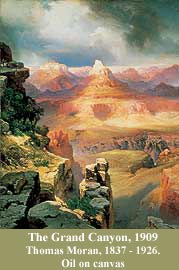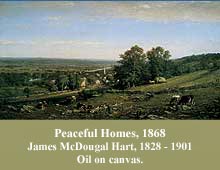
|
|
Around
Tappan Square
|

Art
Museum Exhibition Explores North
American Landscape
IN OVER 60 PAINTINGS, PHOTOGRAPHS, AND WORKS ON PAPER spanning the late 17th century to the present day, Changing Visions of the North American Landscape explores different ways of interpreting visual records of our physical environment. Four sections of the exhibition at the Allen Art Museum examine the viewer's perception and the motives of the artists, including Ansel Adams, Albert Bierstadt, Christo, Thomas Cole, Edward Hopper, George Inness, and Jeff Wall. The process of discovering and documenting the North American continent is outlined in Awesome Spectacles and Majestic Idylls: Coming to terms with the American wilderness. Works in this segment capture the reactions of artists, travelers, explorers, and emigrants to the vast wildernesses of the North American continent. Observers were astounded by the pristine grandeur of the new land, its awe-inspiring topography, and by their encounters with indigenous peoples and exotic flora and fauna. A series of 19th- and 20th-century images of westward expansion documents the Anglo-European tendency for shaping the wilderness to conform to abstract ideals of government and ownership, and a growing consciousness of the impact of these beliefs.
A Bountiful Harvest: Working and Playing on the Land illustrates the molding of the North American landscape for work and recreation. During the 19th century, vast tracts of wilderness were irrevocably transformed to support extensive agriculture and other industries that contributed to the national prosperity. While there were some less than positive aspects to settling in--the isolation of remote settlements, the endless toil of wresting an existence from the land, and the destruction of natural environments--most images are very positive. As more areas were settled during the 19th century, portions of the landscape were designated for organized pleasure and leisure. Parks became part of the landscape. As these images show, there was an explosive rise in escorted excursions and tourist jaunts to carefully maintained pockets of natural beauty. The Urban Landscape examines the city as a modern locus. Beauty is found in an entirely man-made environment dominated by the precision of structures and the tremendous power of machines. Yet, there is still a longing for the natural environment, and artists are drawn to record bits of nature tucked away within congested urban environments, such as tiny parks and individual yards. The fourth section of the exhibition, Landscapes of the Mind, presents a more subjective look at the North American landscape. Nineteenth-century allegories, for example, invoked natural features to represent concepts such as the Ages of Man, or to allude to specific political situations. Artists of the 20th century created a range of individual styles and visual vocabularies to convey personal responses to landscape and environment. From the late 1960s, artists have also produced performance art, sculpture, and earthworks that interact with the landscape itself. |
